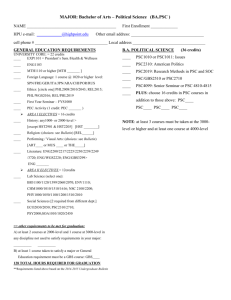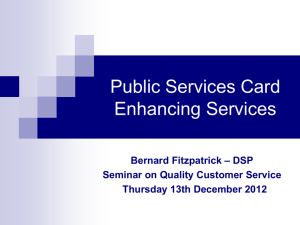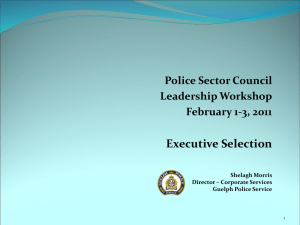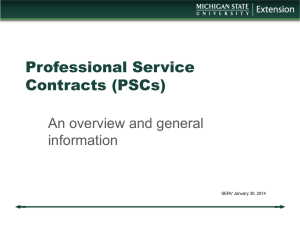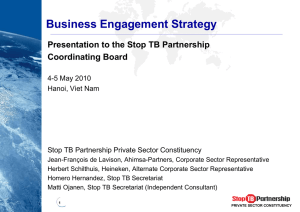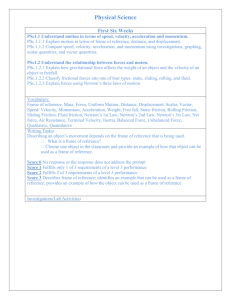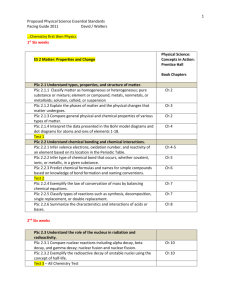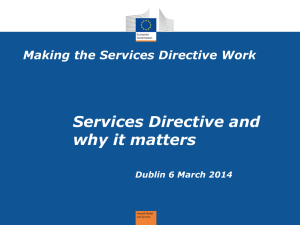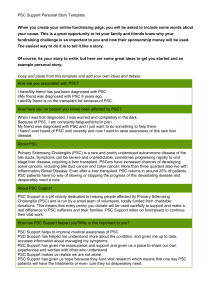Aged Care Staff
advertisement
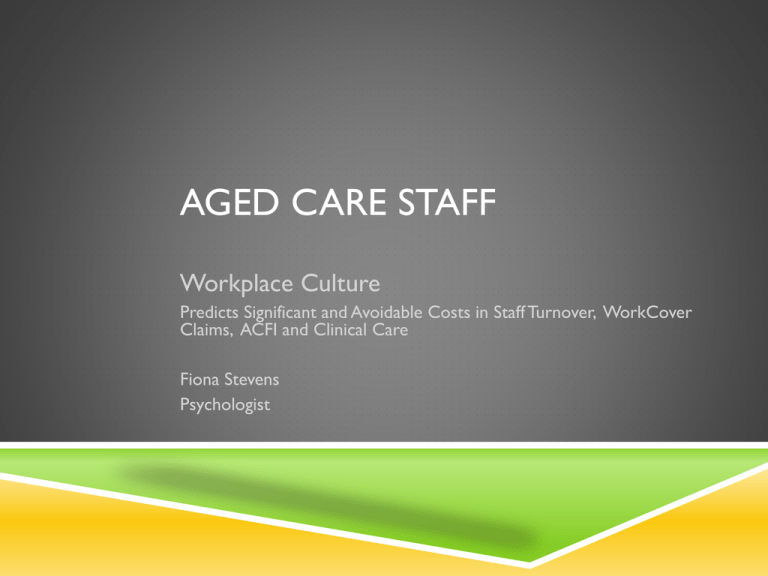
AGED CARE STAFF Workplace Culture Predicts Significant and Avoidable Costs in Staff Turnover, WorkCover Claims, ACFI and Clinical Care Fiona Stevens Psychologist WHAT IS CULTURE? Only human? June 7, 2005 The use of sponges as tools among some dolphins could be the first documented case of a material culture in a marine mammal species. The behavior, called sponging, involves a dolphin affixing a marine sponge over its snout to protect itself while it pokes and prods for fish on the sea floor. Researchers believe the use of this sponge tool is a fishing technique that mother dolphins teach to their children. The study is published in the Proceedings of the National Academy of Sciences. INTRODUCTIONS…… Robert Bowden 08 8357 4988 or 0432 070 623 rbowden@workxtra.com.au www.workxtra.com.au Fiona Stevens 08 8410 2342 or 0402 410 234 fs@centralpsychserv.com.au www.centralpsychserv.com.au Dr Peter Winwood pwinwood@internode.on.net De Stress Consulting who is thinking of their workplace, what are they up to……… what’s your biggest worry? you know your staff also worry about their work Worry about signatures Worry about relationships (bullying) Cry before starting work Can’t sleep Fatigued and poor recovery (wake up and call the facility) Worried about getting everything done 2 ways of looking at it WHAT HAVE WE BEEN UP TO! Got started with support through EML Members Benefit Program We are now up to our 12th facility Based around concept of PSC = PsychoSocialSafetyClimate Extensive research, link between high PSC and organisational outcomes including affective commitment, lower injury rates PSYCHOSOCIAL SAFETY CLIMATE (PSC) “ The philosophies, policies and practices through which Management clearly demonstrates the extent to which employees are valued as a business asset, and their complete health and welfare is protected as a priority”. It is the cause of causes… Factors that make up PSC Management Support & Priority Organisational Commitment & Participation Resources Cognitive, emotional, physical, facility Fatigue and Recovery Bullying and Anti-Social Behaviour Morale, Cynicism, Affective Commitment, Absenteeism Self Care and Home - muscle joint pain PSC CAN BE MEASURED The key outcomes of PSC are: WHS Outcomes: Injuries and Incidents WorkCover Claims and Cost (RTW times) Sick Leave Safe Work Practices Fatigue and Recovery Workplace Engagement and Productivity Outcomes: Workers Engagement Service Quality and Care Complaints Staff Turnover Cynicism Workplace Morale Workplace commitment Employee Productivity Innovation ACFI Funding Safetyclimate PSC = PsychoSocial This is about keeping your staff, your residents safe Low PSC = more ambulence callouts = more incidents including falls = more WC injuries = longer RTW times How safe is that? High PSC = a safer workplace Safety Culture Safety culture is inextricably linked with, but distinguishable from, organisational culture Dependent on how the organisation deals with the often conflicting goals of safety and profitability - and the trade offs between the two The demonstrated level of commitment to safety If an employee is concerned about a safety issue, are channels open to communicate this to management? If so, how will management respond? Are messengers shot? SURGEON SHOOTS DURING OPERATION ANAESTHETIST DEAD-PATIENT FAINTS Rio de Janeiro. Reuters. April 1996. A Brazilian surgeon shot a colleague, who was responsible for the anaesthesia of the patient, during abdominal surgery. While this was happening, the patient woke from anaesthesia and, on seeing the bloodbath, fainted. The Resident who was present attempted to save the life of the anaesthesist, then ended the abdominal operation.The surgeon was long gone over the mountains… There was disagreement regarding the surgery between the two doctors, members of a private clinic at Macae, near Rio de Janeiro, where the operation took place. During the dispute, the 60 year old surgeon, Marcelino Pereira da Silva, took out a revolver and put three shots into the head of Elimson Ribeiro Elais, age 40. Search is on for the surgeon. WHAT HAVE WE FOUND? PSC can be measured and specific tailored interventions can be designed, implemented and measured. Every workplace (and aged care facility) is different and has different needs (even if it is part of a bigger group) By changing PSC you change: Injury rates Clinical care Absenteeism Agency use AGED CARE STUDY 1 Highest rate of musculo skeletal injuries in the WC system Measured the PSC in 6 facilities Compared outcomes including Number of injuries RTW time Cost of injuries Link between PSC and outcome variables ‘A MULTIDISCIPLINARY APPROACH TO INJURY MINIMISATION IN THE AGED CARE HEALTH SECTOR’ A Pilot Project Funded by Employers Mutual Ltd THE SURVEY QUESTIONNAIRE Developed specifically for the ACAA study Has proven remarkably effective in providing insight into a wide range of important aspects of injury in Aged Care Significant Observations High correspondence between direct observations at sites and measured PSC level Consistent with the top down nature of PSC, the significant role of the actual site manager (whether this is Owner Proprietor or another. Identifying ‘Hot Spots’ within the organisation i.e. RN group Ongoing value of the questionnaire Benchmarking – assessing the individual facility against industry standards Guiding targeted interventions Study Facility Claims and Costs for Injuries Reported Since July 2008 Facility Name High PSC Facility 2008/2009 2009/2010 Low PSC Facility 2008/2009 2009/2010 EAP Yes Yes No No No of No Type of Claim Cost of Employ Claim Physica Claims Psych Total ees s l 53 52 120 120 4 2 18 9 3 2 18 9 1 0 0 0 7330 288 High Claim (s) Cost /Head 5087 288 $138 $5 160521 (159797) Mean Costs 2 yrs prior 2687 $3733 37774 17231 $314 242878 447983 Table 1: Observed Difference in WorkCover Claims in High and Low PSC facilities in the Study (Exemplar) PSC AND WORKCOVER CLAIMS COSTS Figure 1: Relationship between PSC Levels and Claims Costs per Employee within Study Facilities STUDY 2 Ongoing Looking at the most efficient ways to change organisations Debrief the stats with all staff = “stories behind the stats” Enables change via the exec group getting detailed feedback Targetted programs eg “Handling Work Handling You” EAP services especially physiotherapy alters culture immediately = ok to ask for help Repeat questionnaires – any changes? HOW TO CHANGE PSC ‘... there is no more delicate matter to take in hand, nor more dangerous to conduct, nor more doubtful in its success, than to set up as a leader in the introduction of changes. For he who innovates will have for his enemies all those who are well off under the existing order of things, and only lukewarm supporters in those who might be better off under the new.’ (Machiavelli, 1469–1527) UPPLIFT APPROACH PSC Floor/Care/Service Staff EN RN Clinical Nurses Area/Facility Managers CEO/Executive Board INVESTIGATING PSC ACROSS WORK AREAS VARIATION IN REPORTED RESOURCES BY WORK AREA FATIGUE & RECOVERY ACCORDING TO WORK AREA BULLYING REPORTS ACCORDING TO WORK AREA WORK MORALE, ETC. ACCORDING TO WORK AREA WORK ENGAGEMENT BY WORK AREA Summary Points • Look at your difficulties in your organisations as opportunities to learn about your people to create change. • Your culture is measurable and effects all outcomes of your business Summary Points • YOU are responsible to create and influence PSC – it will change – why not make sure it changes to your expectations • Please look at Workplace injuries and bullying differently…… • Learn more about real leadership QUESTIONS ?

